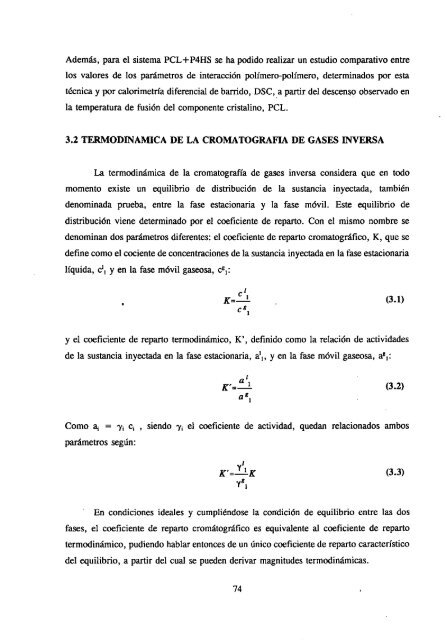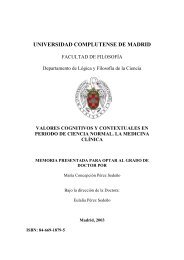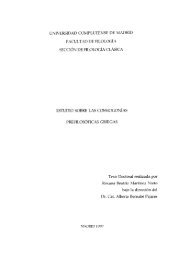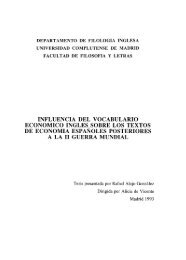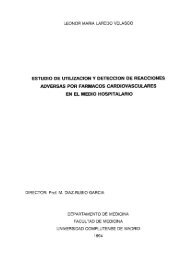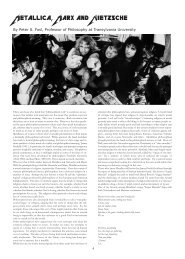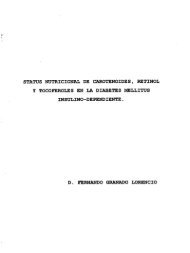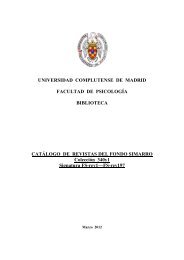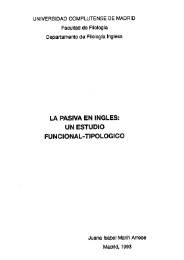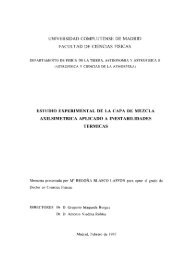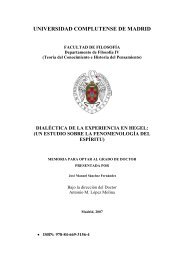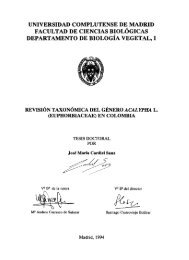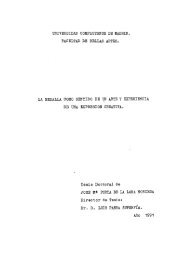ilflENDINM - Biblioteca de la Universidad Complutense ...
ilflENDINM - Biblioteca de la Universidad Complutense ...
ilflENDINM - Biblioteca de la Universidad Complutense ...
Create successful ePaper yourself
Turn your PDF publications into a flip-book with our unique Google optimized e-Paper software.
A<strong>de</strong>más, para el sistema PCL+P4HS se ha podido realizar un estudio comparativo entre<br />
los valores <strong>de</strong> los parámetros <strong>de</strong> interacción polímero-polímero, <strong>de</strong>terminados por esta<br />
técnica y por calorimetría diferencial <strong>de</strong> barrido, DSC, a partir <strong>de</strong>l <strong>de</strong>scenso observado en<br />
<strong>la</strong> temperatura <strong>de</strong> fusión <strong>de</strong>l componente cristalino, PCL.<br />
3.2 TERMODINÁMICA DE LA CROMATOGRAFIA DE GASES INVERSA<br />
La termodinámica <strong>de</strong> <strong>la</strong> cromatografía <strong>de</strong> gases inversa consi<strong>de</strong>ra que en todo<br />
momento existe un equilibrio <strong>de</strong> distribución <strong>de</strong> <strong>la</strong> sustancia inyectada, también<br />
<strong>de</strong>nominada prueba, entre <strong>la</strong> fase estacionaria y <strong>la</strong> fase móvil. Este equilibrio <strong>de</strong><br />
distribución viene <strong>de</strong>terminado por el coeficiente <strong>de</strong> reparto. Con el mismo nombre se<br />
<strong>de</strong>nominan dos parámetros diferentes: el coeficiente <strong>de</strong> reparto cromatográfico, K, que se<br />
<strong>de</strong>fine como el cociente <strong>de</strong> concentraciones <strong>de</strong> <strong>la</strong> sustancia inyectada en <strong>la</strong> fase estacionaria<br />
líquida, c’ 1 y en <strong>la</strong> fase móvil gaseosa, ~<br />
y el coeficiente <strong>de</strong> reparto termodinámico, K’, <strong>de</strong>finido como <strong>la</strong> re<strong>la</strong>ción <strong>de</strong> activida<strong>de</strong>s<br />
<strong>de</strong> <strong>la</strong> sustancia inyectada en <strong>la</strong> fase estacionaria, a1, y en <strong>la</strong> fase móvil gaseosa, a 5 1:<br />
1<br />
a 1<br />
a<br />
(3.1)<br />
(3.2)<br />
Como a1 = -y~ c1 , siendo y~ el coeficiente <strong>de</strong> actividad, quedan re<strong>la</strong>cionados ambos<br />
parámetros según:<br />
K’ (3.3)<br />
g<br />
TI<br />
En condiciones i<strong>de</strong>ales y cumpliéndose <strong>la</strong> condición <strong>de</strong> equilibrio entre <strong>la</strong>s dos<br />
fases, el coeficiente <strong>de</strong> reparto cromátográfico es equivalente al coeficiente <strong>de</strong> reparto<br />
termodinámico, pudiendo hab<strong>la</strong>r entonces <strong>de</strong> un único coeficiente <strong>de</strong> reparto característico<br />
<strong>de</strong>l equilibrio, a partir <strong>de</strong>l cual se pue<strong>de</strong>n <strong>de</strong>rivar magnitu<strong>de</strong>s termodinámicas.<br />
74


